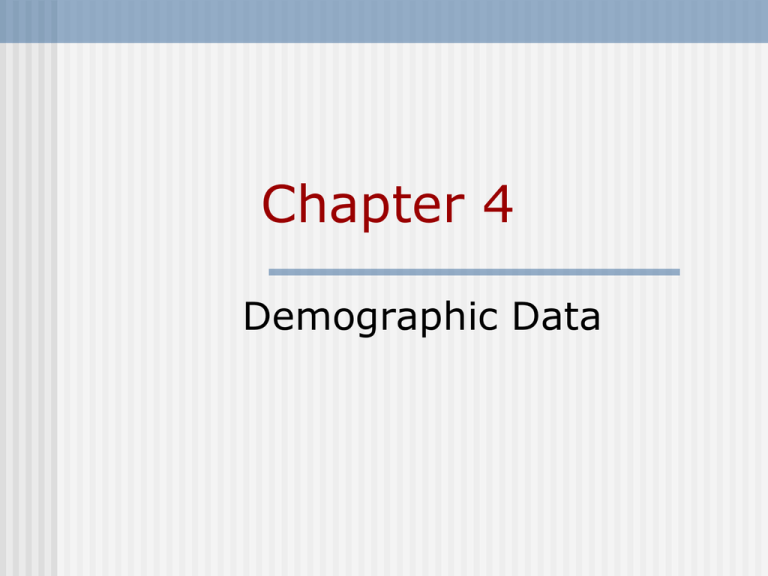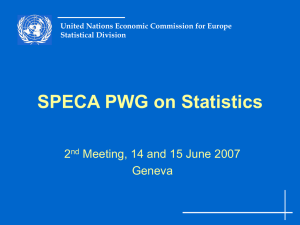Chapter 4
advertisement

Chapter 4 Demographic Data Sources of Demographic Data • Census of population population, demographic structure and characteristics. • Registration of vital statistics population processes of births and deaths • Administrative data Local population changes, geographic mobility and migration Other Sources of Demographic Data • Historical Records – Family Bibles, Church records. Ships Manifest • Population Registers. – Complete demographic history of individuals. Census of Population • The term “census” is from the Latin word meaning to assess. • Ancient censuses differed from modern censuses because they were largely used for taxation and military purposes Populations in the Census • de facto population - people who are in a given territory on census day • de jure population - people who legally “belong” to a given area, regardless of whether they were there on the day of the census • people included in the census on the basis of usual residence - roughly defined as the place where a person usually sleeps (U.S., Canada, Mexico) Census of Population • Both China and India conducted censuses early in the twenty-first century. • The Canadian, Mexican, and U.S. censuses use a both a 100% short form and a more detailed sample form. Which Area of the World is least likely to have had its populations recently enumerated in a Census? D C B A Problems with Censuses • No census has been taken in Lebanon since before World War II. • Census was cancelled in the Netherlands in 1980’s • Nigerian Census in 1991 occurred only after agreeing on no questions concerning ethnic groups. Population Census U.S.: Censuses have been taken every 10 years since 1790. Canada: Censuses have been taken every 10 years since 1851 and every 5 years since 1951. Mexico: Censuses have been taken every 10 years since 1900, and every 5 years since 1990. What we learn from the U.S.Census • Reapportionment of the House of Representatives (Most important) • Provides data for Federal Funding Formulas • Basic Demographic Data for the United States Controversies with the U.S. Census. • Counting of African slaves. 3/5 compromise. • Undercounting minorities • Counting Homeless persons. • Counting of illegal aliens. Differential Undercounting Administrative Records • Demographic information derived from administrative records, including tax returns, utility records, school enrollment, and participation in government programs. Administrative Records • Bills of Mortality. – First used by John Graunt to study infant mortality. • Draft registration WWI draft registration demonstrated the undercount of African-Americans. Vital Statistics • The two most important demographic events recorded by vital statistics are births and deaths. • Vital statistics and survey data are necessary to accurately estimate the rate of population growth in the years between censuses. Combining data from different sources provides clearer picture of change. • Vital Statistics provide information on births and deaths. • Administrative data to provide information on migration. • Census data is often combined with other sources of data to calculate rates. Demographic Balancing Equation P2=P1+B-D+I-O • • • • • P2-Population(time 2) P1-Population(time 1) B-Births D-Deaths I–In-migration O= Out-migration Demographic Balancing Equation • Vital Statistics (Births – Deaths) = Natural Increase. • Administrative data – IRS. In – Out Migration = Net Migration. Variations of the Demographic Balancing Equation • Net Migration = Pop(t2) – Pop(t1) – Deaths + Births. Census Errors: Nonsampling • Content Error Problems with the accuracy of the data obtained in the census. • Includes nonresponses to particular questions on the census or inaccurate responses if people do not understand the question. Content Error • Example 1. Single Mom living with adult son and his girlfriend. Identifies girlfriend as unmarried partner meaning her sons unmarried partner. • Example 2. Persons of Hispanic descent listing other race then filling in hispanic or latino. • Example 3. Questionaire fatigue. Coverage error Measuring coverage error in a census? • demographic analysis demographic balancing equation • dual system estimation A.C.E. Accuracy and Coverage Evaluation. Sample surveys Used frequently to gather demographic data. Provide less extensive geographic coverage than a census or system of vital registration. Sampling Errors • If any data in a census are collected on a sample basis, sampling error is introduced in the results. • Sampling error is readily measured based on the mathematics of probability. • Samples can be designed to ensure comparable levels of error across groups. Sample surveys • United States American Community Survey (ACS) Current Population Survey (CPS) • Canada Labor Force Survey (LFS) • Mexico Encuesta Nacional de Ocupacion y Empleo • Demographic and Health Surveys (DHS) Sample surveys • Demographic and Health Surveys (DHS) 170 surveys conducted in more than 70 developing countries in Africa, western Asia and Latin America. Demographic Health Survey • Focused on fertility, reproductive health and child health and nutrion. • Serves as a substitute for vital statistics in many developing nations. Difficulties Using Data • Data collected in the census, by the vital statistics registration system, or derived from administrative records: 1. Usually collected for purposes other than demographic analysis and do not reflect the theoretical concerns of demography. 2. Collected by many different people using different methods and may be prone to numerous kinds of error. Geographic Information Systems (GIS) • Computer-based system that brings maps together with data in innovative ways. • Geo-referencing data to places on the map means different types of data can be combined for the same place, and for more than one time. • Increases the ability to visualize and analyze demographic changes over time and space. Mississippi Counties by Percent Black 1940-2000 Census Geography






